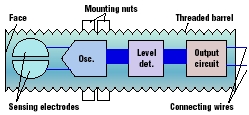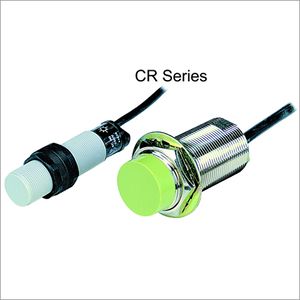Capacitive Proximity Sensors
Capacitive Proximity Sensors are similar to Inductive Proximity Sensors. The main difference between the two types is that capacitive proximity sensors produce an electrostatic field instead of an electromagnetic field. Capacitive proximity switches will sense metal as well as nonmetallic materials such as paper, glass, liquids, and cloth.
The sensing surface of a capacitive sensor is formed by two concentrically shaped metal electrodes of an unwound capacitor. When an object nears the sensing surface it enters the electrostatic field of the electrodes and changes the capacitance in an oscillator circuit. As a result, the oscillator begins oscillating. The trigger circuit reads the oscillator’s amplitude and when it reaches a specific level the output state of the sensor changes. As the target moves away from the sensor the oscillator’s amplitude decreases, switching the sensor output back to its original state.
Capacitive proximity sensor that detects nearby objects by their effect on the electrical field created by the sensor. Simple capacitive sensors have been commercially available for many years, and have found a niche in nonmetallic object detection, but are limited to short ranges, typically less than 1 cm. Capacitive sensors have some similarities to radar in their ability to detect conductive materials, while seeing through insulating materials such as wood or plastic. In practice, the differences are considerable; When compared to Radar Sensors, capacitive sensors:
- Are simpler, so are potentially smaller, less expensive and less power-hungry.
- Are proximity sensors, rather than range sensors. They do not give a direct indication of how far away the detected object is. A more distant strong target can give the same response as a nearby weak target.
- Are non-directional and have a short range.
When used for detecting objects all around a vehicle, some of the disadvantages of the capacitive sensor are less problematic. A practical system has many sensors regularly spaced around the outside of the vehicle. This means that there is always a sensor close by, so no great range is required, and objects can be roughly localized by which sensor they are detected in. Non-directional response is actually desirable, since it can detect objects that are between sensors but very close to the vehicle.
Most proximity sensors use an electromagnetic field to sense the presence of a target metal. But there are times when it's necessary to sense nonmetallic materials such as plastics, liquids, or powders. Capacitive proximity sensors detect a wide variety of materials. For instance, capacitive sensors are often used to detect granular or powdered materials like plastic pellets in injection-molding hoppers. And intrinsically safe units sense the level of organic materials like rice, barley malt, corn, and soybeans in possibly explosive areas, such as grain elevators.
Two metallic electrodes or plates create the sensing element in a capacitive proximity sensors. The electrodes form a capacitor in the feedback loop of a high-frequency oscillator. The amount of capacitance is a function of the surface area of the two electrodes, the distance between the electrodes, and the dielectric constant of the material between the electrodes. The capacitance is low with no target present, so the oscillation amplitude is small. A target approaching the face of the sensor changes the dielectric constant between the plates and raises the capacitance. The higher capacitance boosts the amplitude of the oscillations being measured by a level-detection circuit. When the amplitude of the oscillations exceeds a specific value, the level detector turns on the output of the sensor. As oscillation amplitude falls below the threshold, the level detector turns the sensor output off.
Conductive targets affect capacitive sensors as well, but in a different way. When a conductive target enters the sensor field it forms a counter electrode to the active face of the sensor. The target effectively reduces the distance between electrodes and boosts the average surface area. The net result is a jump in the capacitance value, the same as for a nonconductive target.

